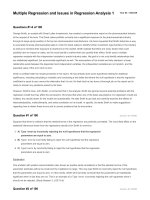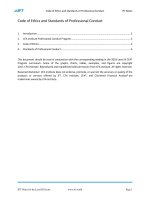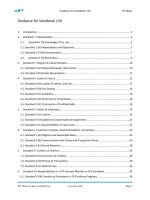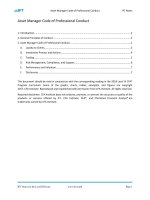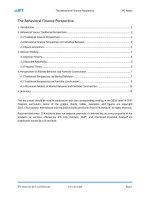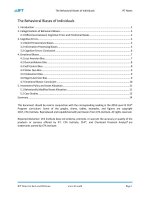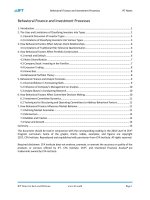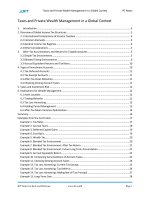CFA 2018 level 3 schweser practice exam CFA 2018 level 3 question bank 02 behavioral finance questions
Bạn đang xem bản rút gọn của tài liệu. Xem và tải ngay bản đầy đủ của tài liệu tại đây (17.83 KB, 4 trang )
BEHAVIORAL FINANCE
QUESTION 1 HAS ONE PART FOR A TOTAL OF 9 MINUTES.
Samnang Kahn works for World Financial Management (WFM) as a portfolio manager for
individual investors. Kahn is preparing for the yearly review of several of his clients with the
first one being Kenneth Clark. Clark is in his early 50s, divorced with two children, and has a
total net worth of approximately $500,000. Clark works as an electrical engineer and also has an
MBA. He has been investing for some time on his own. When he first started investing, he
thought his MBA gave him the expert knowledge needed to be a proficient investor. After
several years of mediocre performance of his investments, he realized he should get some
professional help. This led to his relationship with Kahn.
One of Clark’s stocks is called X-wire, which Clark is familiar with from working in the
engineering field. Historically, X-wire has performed well and this led Clark to believe it would
continue to do so in the future. After buying the X-wire stock it continued to do well for a short
period of time and then decreased in price below Clark’s original purchase price. Clark is
reluctant to sell it in hopes of at least breaking even in the near future.
For each statement in the template provided below, state the most likely behavioral bias Clark is
exhibiting from the following choices: loss aversion, overconfidence, myopic loss aversion,
representative bias, or fear of regret. Use any behavioral bias only once. Explain one
consequence of the behavior from a portfolio perspective.
(9 minutes)
Statement
State the most
likely
behavioral bias
being
exhibited.
Explain one consequence of the behavior from
a portfolio perspective.
When he first started
investing, he thought his
MBA gave him the expert
knowledge needed to be a
proficient investor.
Historically, X-wire has
performed well and this led
Clark to believe it would
continue to do so in the
future.
1
After buying the X-wire stock
it continued to do well for a
short period of time and then
decreased in price below
Clark’s original purchase
price. Clark is reluctant to sell
it in hopes of at least breaking
even in the near future.
QUESTION 2 HAS TWO PARTS (A, B) FOR A TOTAL OF 8 MINUTES.
Michelle King is thinking about making changes to her defined contribution plan. When King
started making contributions into her plan she left her investments alone for several years,
maintaining the same asset allocation as she originally started with. Because of this unsuccessful
strategy, King then diversified equally among all the different investment options available to her
in her plan. Over time, King has become more knowledgeable about investing and realized she
needs to determine what her level of risk aversion is and allocate her portfolio accordingly,
taking into consideration the number of years until she retires.
A.
Identify and describe two behavioral traits King displayed while investing in her defined
contribution plan.
(4 minutes)
B.
State one advantage and one disadvantage of the pyramid structure as an investment
strategy for individual investors.
(4 minutes)
2
QUESTION 3 HAS FOUR PARTS (A, B, C, D) FOR A TOTAL OF 15 MINUTES
Peter Dangforth is a new CFA charterholder with big plans to convince his partners that
behavioral finance concepts can increase profitability for their investment management business.
He tells them the following:
Traditional finance is descriptive of how investors actually invest their money. It assumes
markets are efficient and allows the manager to focus on asset allocation rather than
identification of misvalued securities.
Behavioral finance assumes investors have greater decision-making ability and are risk
seekers.
Traditional finance is based on utility theory while behavioral finance assumes that, in some
cases, prospect theory and loss aversion are more useful in understanding clients.
A. For each of the first two statements made by Dangforth, identify one thing that is incorrect
and restate each statement in a way that is correct.
(4 minutes)
B. Regarding Dangforth’s third statement, explain two ways that utility theory and loss aversion
differ.
(4 minutes)
3
Later in the week, Dangforth has two meetings.
First is a meeting with a longtime client of the firm but a new client for Dangforth. His
coworkers warn him that the client is very demanding and regularly brings up the time his former
manager was heavily invested in technology stocks, right before the technology stock price
bubble burst.
Second is the monthly Investment Policy Committee meeting for the firm. Dangforth finds the
meetings unproductive. Key issues are not discussed, trivial issues drag on, and people forget
what has already been decided. He really wishes this could change. He is particularly frustrated
because, as individuals, each committee member is well qualified, and collectively, the
committee has all the skills needed.
C. Identify one contributing factor that behavioral finance suggests can explain market bubbles,
and explain how that factor can contribute to markets becoming overvalued.
(3 minutes)
D. Explain why behavioral factors can be a greater impediment to effective investment decision
making for investment committees than for individual committee members, and state two
actions the committee chairman can implement to improve the effectiveness of this firm’s
committee.
(4 minutes)
4
